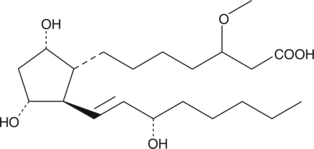Chemicals
Showing 5251–5400 of 41137 results
-
3-hydroxy Tridecanoic acid methyl ester is a hydroxylated fatty acid methyl ester and major fatty acid component of A. lipolytica and A. glycerini.{41600} It has been used in the synthesis of components of the female sex pheromone of the painted apple moth (T. anartoides).{41601} [Matreya, LLC. Catalog No. 1734]
Brand:CaymanSKU:24644 - 5 mgAvailable on backorder
3-hydroxy Undecanoic acid is a hydroxylated fatty acid that has been found in S. algae, LPS extracted from clinical isolates of B. catarrhalis, and methyl-branched poly(3-hydroxyalkanoate) (PHA) polymers produced by P. flava isolated from oil-contaminated soil.{38904,38905,38906} It inhibits sodium current in axons dissected from mantles of giant squid (D. bleekeri) with an ED50 value of 0.46 mM.{38907} [Matreya, LLC. Catalog No. 1729]
Brand:CaymanSKU:24640 - 25 mgAvailable on backorder
3-hydroxy Undecanoic acid methyl ester is a hydroxylated fatty acid methyl ester that has been found in methyl-branched poly(3-hydroxyalkanoate) (PHA) polymers produced by P. oleovorans, P. putida, and D. tsuruhatensis.{40824,40825} [Matreya, LLC. Catalog No. 1730]
Brand:CaymanSKU:24641 - 25 mgAvailable on backorder
The enzyme 3-hydroxy-3-methylglutaryl-coenzyme A (HMG-CoA) reductase mediates the rate-limiting step in cholesterol synthesis, converting HMG-CoA to mevalonate.{30161} 3-hydroxy-3-Methylglutaric anhydride is a precursor that is used in the synthesis of HMG-CoA.{30160,30159} It has also been used in the synthesis of 3-alkyl-3-hydroxyglutaric acids that act as inhibitors of HMG-CoA reductase.{30158}
Brand:CaymanSKU:-Available on backorder
The enzyme 3-hydroxy-3-methylglutaryl-coenzyme A (HMG-CoA) reductase mediates the rate-limiting step in cholesterol synthesis, converting HMG-CoA to mevalonate.{30161} 3-hydroxy-3-Methylglutaric anhydride is a precursor that is used in the synthesis of HMG-CoA.{30160,30159} It has also been used in the synthesis of 3-alkyl-3-hydroxyglutaric acids that act as inhibitors of HMG-CoA reductase.{30158}
Brand:CaymanSKU:-Available on backorder
The enzyme 3-hydroxy-3-methylglutaryl-coenzyme A (HMG-CoA) reductase mediates the rate-limiting step in cholesterol synthesis, converting HMG-CoA to mevalonate.{30161} 3-hydroxy-3-Methylglutaric anhydride is a precursor that is used in the synthesis of HMG-CoA.{30160,30159} It has also been used in the synthesis of 3-alkyl-3-hydroxyglutaric acids that act as inhibitors of HMG-CoA reductase.{30158}
Brand:CaymanSKU:-Available on backorder
3-hydroxy-DL-Kynurenine is an active metabolite of tryptophan.{42852,42853,42854} It inhibits yeast and rat liver aldehyde dehydrogenase by 97 and 69%, respectively, when used at a concentration of 100 μM.{42852} 3-hydroxy-DL-Kynurenine is active against methicillin-resistant S. aureus (MRSA), S. epidermidis, vancomycin-resistant E. faecalis (VRE), E. coli, multidrug-resistant P. aeruginosa (MDRP), and C. albicans (IC50s = 31.2, 39.2, 57.6, 24, 25.6, and 137.6 μg/ml, respectively).{42853} It increases intracellular NAD+ levels and extracellular lactate dehydrogenase (LDH) activity in human neurons and astrocytes in a concentration-dependent manner.{42854}
Brand:CaymanSKU:27778 - 10 mgAvailable on backorder
3-hydroxy-DL-Kynurenine is an active metabolite of tryptophan.{42852,42853,42854} It inhibits yeast and rat liver aldehyde dehydrogenase by 97 and 69%, respectively, when used at a concentration of 100 μM.{42852} 3-hydroxy-DL-Kynurenine is active against methicillin-resistant S. aureus (MRSA), S. epidermidis, vancomycin-resistant E. faecalis (VRE), E. coli, multidrug-resistant P. aeruginosa (MDRP), and C. albicans (IC50s = 31.2, 39.2, 57.6, 24, 25.6, and 137.6 μg/ml, respectively).{42853} It increases intracellular NAD+ levels and extracellular lactate dehydrogenase (LDH) activity in human neurons and astrocytes in a concentration-dependent manner.{42854}
Brand:CaymanSKU:27778 - 100 mgAvailable on backorder
3-hydroxy-DL-Kynurenine is an active metabolite of tryptophan.{42852,42853,42854} It inhibits yeast and rat liver aldehyde dehydrogenase by 97 and 69%, respectively, when used at a concentration of 100 μM.{42852} 3-hydroxy-DL-Kynurenine is active against methicillin-resistant S. aureus (MRSA), S. epidermidis, vancomycin-resistant E. faecalis (VRE), E. coli, multidrug-resistant P. aeruginosa (MDRP), and C. albicans (IC50s = 31.2, 39.2, 57.6, 24, 25.6, and 137.6 μg/ml, respectively).{42853} It increases intracellular NAD+ levels and extracellular lactate dehydrogenase (LDH) activity in human neurons and astrocytes in a concentration-dependent manner.{42854}
Brand:CaymanSKU:27778 - 25 mgAvailable on backorder
3-hydroxy-DL-Kynurenine is an active metabolite of tryptophan.{42852,42853,42854} It inhibits yeast and rat liver aldehyde dehydrogenase by 97 and 69%, respectively, when used at a concentration of 100 μM.{42852} 3-hydroxy-DL-Kynurenine is active against methicillin-resistant S. aureus (MRSA), S. epidermidis, vancomycin-resistant E. faecalis (VRE), E. coli, multidrug-resistant P. aeruginosa (MDRP), and C. albicans (IC50s = 31.2, 39.2, 57.6, 24, 25.6, and 137.6 μg/ml, respectively).{42853} It increases intracellular NAD+ levels and extracellular lactate dehydrogenase (LDH) activity in human neurons and astrocytes in a concentration-dependent manner.{42854}
Brand:CaymanSKU:27778 - 50 mgAvailable on backorder
Glutaryl-CoA dehydrogenase (GCDH) is a mitochondrial matrix protein that catalyzes the oxidative decarboxylation of glutaryl-CoA to crotonyl-CoA and carbon dioxide in the catabolic pathways of lysine, hydroxylysine, and tryptophan metabolism.{13906} 3-Hydroxyglutaric acid is one of several metabolites produced when insufficient levels of GCDH are available.{16334,13906} Urinary levels of 3-hydroxyglutaric acid are elevated during glutaric acidemia type 1, an autosomal recessive GCDH deficiency disorder that can lead to neurodegeneration if left untreated.{16334,13906} 3-Hydroxyglutaric acid is used as a biomarker of GCDH deficiency.{16334,13906}
Brand:CaymanSKU:-Out of stock
Glutaryl-CoA dehydrogenase (GCDH) is a mitochondrial matrix protein that catalyzes the oxidative decarboxylation of glutaryl-CoA to crotonyl-CoA and carbon dioxide in the catabolic pathways of lysine, hydroxylysine, and tryptophan metabolism.{13906} 3-Hydroxyglutaric acid is one of several metabolites produced when insufficient levels of GCDH are available.{16334,13906} Urinary levels of 3-hydroxyglutaric acid are elevated during glutaric acidemia type 1, an autosomal recessive GCDH deficiency disorder that can lead to neurodegeneration if left untreated.{16334,13906} 3-Hydroxyglutaric acid is used as a biomarker of GCDH deficiency.{16334,13906}
Brand:CaymanSKU:-Out of stock
Glutaryl-CoA dehydrogenase (GCDH) is a mitochondrial matrix protein that catalyzes the oxidative decarboxylation of glutaryl-CoA to crotonyl-CoA and carbon dioxide in the catabolic pathways of lysine, hydroxylysine, and tryptophan metabolism.{13906} 3-Hydroxyglutaric acid is one of several metabolites produced when insufficient levels of GCDH are available.{16334,13906} Urinary levels of 3-hydroxyglutaric acid are elevated during glutaric acidemia type 1, an autosomal recessive GCDH deficiency disorder that can lead to neurodegeneration if left untreated.{16334,13906} 3-Hydroxyglutaric acid is used as a biomarker of GCDH deficiency.{16334,13906}
Brand:CaymanSKU:-Out of stock
Glutaryl-CoA dehydrogenase (GCDH) is a mitochondrial matrix protein that catalyzes the oxidative decarboxylation of glutaryl-CoA to crotonyl-CoA and carbon dioxide in the catabolic pathways of lysine, hydroxylysine, and tryptophan metabolism.{13906} 3-Hydroxyglutaric acid is one of several metabolites produced when insufficient levels of GCDH are available.{16334,13906} Urinary levels of 3-hydroxyglutaric acid are elevated during glutaric acidemia type 1, an autosomal recessive GCDH deficiency disorder that can lead to neurodegeneration if left untreated.{16334,13906} 3-Hydroxyglutaric acid is used as a biomarker of GCDH deficiency.{16334,13906}
Brand:CaymanSKU:-Out of stock
3-Hydroxyglutaric acid dimethyl ester is a prochiral substrate and an esterified derivative of 3-hydroxyglutaric acid (Item No. 16334).{40124} 3-Hydroxyglutaric acid dimethyl ester was used to characterize the ability of a lipase from C. antarctica to catalyze aminolysis of prochiral substrates, a process commonly utilized in the biosynthesis of statins.
Brand:CaymanSKU:22919 - 1 gAvailable on backorder
3-Hydroxyglutaric acid dimethyl ester is a prochiral substrate and an esterified derivative of 3-hydroxyglutaric acid (Item No. 16334).{40124} 3-Hydroxyglutaric acid dimethyl ester was used to characterize the ability of a lipase from C. antarctica to catalyze aminolysis of prochiral substrates, a process commonly utilized in the biosynthesis of statins.
Brand:CaymanSKU:22919 - 10 gAvailable on backorder
3-Hydroxyglutaric acid dimethyl ester is a prochiral substrate and an esterified derivative of 3-hydroxyglutaric acid (Item No. 16334).{40124} 3-Hydroxyglutaric acid dimethyl ester was used to characterize the ability of a lipase from C. antarctica to catalyze aminolysis of prochiral substrates, a process commonly utilized in the biosynthesis of statins.
Brand:CaymanSKU:22919 - 25 gAvailable on backorder
3-Hydroxyglutaric acid dimethyl ester is a prochiral substrate and an esterified derivative of 3-hydroxyglutaric acid (Item No. 16334).{40124} 3-Hydroxyglutaric acid dimethyl ester was used to characterize the ability of a lipase from C. antarctica to catalyze aminolysis of prochiral substrates, a process commonly utilized in the biosynthesis of statins.
Brand:CaymanSKU:22919 - 5 gAvailable on backorder
3-Hydroxyisobutyrate (3-HIB) is an intermediate in the metabolism of the branched-chain amino acid valine that is secreted by skeletal muscle.{45049,43558} It dose-dependently increases fatty acid uptake by human umbilical vein endothelial cells (HUVECs) when used at concentrations ranging from 0.1 to 100 mM.{43558} 3-HIB also increases fatty acid uptake and lipid accumulation in mouse skeletal muscle when administered in drinking water. The levels of 3-HIB in muscle are increased in db/db diabetic mice and in humans with diabetes. Human plasma levels are increased in obesity and correlate with a future risk of type 2 diabetes.{43559} In addition, human serum levels of 3-HIB decrease by 2.5-fold immediately following an exercise regimen of 2.5 hours of running for three days.{45049}
Brand:CaymanSKU:26105 - 1 gAvailable on backorder
3-Hydroxyisobutyrate (3-HIB) is an intermediate in the metabolism of the branched-chain amino acid valine that is secreted by skeletal muscle.{45049,43558} It dose-dependently increases fatty acid uptake by human umbilical vein endothelial cells (HUVECs) when used at concentrations ranging from 0.1 to 100 mM.{43558} 3-HIB also increases fatty acid uptake and lipid accumulation in mouse skeletal muscle when administered in drinking water. The levels of 3-HIB in muscle are increased in db/db diabetic mice and in humans with diabetes. Human plasma levels are increased in obesity and correlate with a future risk of type 2 diabetes.{43559} In addition, human serum levels of 3-HIB decrease by 2.5-fold immediately following an exercise regimen of 2.5 hours of running for three days.{45049}
Brand:CaymanSKU:26105 - 250 mgAvailable on backorder
3-Hydroxypropionic acid is a building block in the synthesis of a variety of compounds with industrial applications, including acrylic acid, acrylamide, and 1,3-propanediol.{43977,43978} Accumulation of 3-hydroxypropionic acid is also used as a biomarker of defects in propionic acid and branched-chain amino acid catabolism in patients with methylmalonic acidemia or propionic acidemia.{43988}
Brand:CaymanSKU:27603 - 1 gAvailable on backorder
3-Hydroxypropionic acid is a building block in the synthesis of a variety of compounds with industrial applications, including acrylic acid, acrylamide, and 1,3-propanediol.{43977,43978} Accumulation of 3-hydroxypropionic acid is also used as a biomarker of defects in propionic acid and branched-chain amino acid catabolism in patients with methylmalonic acidemia or propionic acidemia.{43988}
Brand:CaymanSKU:27603 - 100 mgAvailable on backorder
3-Hydroxypropionic acid is a building block in the synthesis of a variety of compounds with industrial applications, including acrylic acid, acrylamide, and 1,3-propanediol.{43977,43978} Accumulation of 3-hydroxypropionic acid is also used as a biomarker of defects in propionic acid and branched-chain amino acid catabolism in patients with methylmalonic acidemia or propionic acidemia.{43988}
Brand:CaymanSKU:27603 - 250 mgAvailable on backorder
3-Hydroxypropionic acid is a building block in the synthesis of a variety of compounds with industrial applications, including acrylic acid, acrylamide, and 1,3-propanediol.{43977,43978} Accumulation of 3-hydroxypropionic acid is also used as a biomarker of defects in propionic acid and branched-chain amino acid catabolism in patients with methylmalonic acidemia or propionic acidemia.{43988}
Brand:CaymanSKU:27603 - 500 mgAvailable on backorder
3-Hydroxyterphenyllin is a p-terphenyl fungal metabolite originally isolated from A. candidus that has diverse biological activities, including antioxidant, antiproliferative, antibacterial, and antiviral properties.{42907,42908,38480,37200} It has a 96% scavenging effect on 2,2-diphenyl-1-picrylhydrazyl radicals (DPPH; Item No. 14805) when used at a concentration of 100 μg/ml.{42908} 3-Hydroxyterphenyllin inhibits the growth of HeLa cervical, A549 lung, and HepG2 liver cancer cells (IC50s = 23, 36, and 32 μM, respectively), as well as methicillin-resistant S. aureus (MRSA) and V. vulnificus bacteria (MIC = 31 μg/ml for both).{38480} It also inhibits HIV-1 integrase in both coupled and strand transfer assays (IC50s = 2.8 and 12.1 μM, respectively).{37200}
Brand:CaymanSKU:28502 - 1 mgAvailable on backorder
Some halogenated amphetamines deplete brain serotonin levels and display pronounced neurotoxicity.{25537} 3-Iodoamphetamine is a halogenated amphetamine featuring an iodine atom at the meta position of the phenyl group. The physiological and toxicological properties of this compound are not known. This product is intended for forensic and research applications.
Brand:CaymanSKU:9001852 - 1 mgAvailable on backorder
Some halogenated amphetamines deplete brain serotonin levels and display pronounced neurotoxicity.{25537} 3-Iodoamphetamine is a halogenated amphetamine featuring an iodine atom at the meta position of the phenyl group. The physiological and toxicological properties of this compound are not known. This product is intended for forensic and research applications.
Brand:CaymanSKU:9001852 - 10 mgAvailable on backorder
Some halogenated amphetamines deplete brain serotonin levels and display pronounced neurotoxicity.{25537} 3-Iodoamphetamine is a halogenated amphetamine featuring an iodine atom at the meta position of the phenyl group. The physiological and toxicological properties of this compound are not known. This product is intended for forensic and research applications.
Brand:CaymanSKU:9001852 - 5 mgAvailable on backorder
3-Iodothyronamine is derived from the deiodination and decarboxylation of endogenous thyroxine. It activates the G protein-coupled receptor known as trace amine-associated receptor 1 at nanomolar concentrations whereupon it rapidly influences thyroid hormone actions including body temperature, heart rate, and cardiac output.{22581,26261} It has also been reported to function in controlling lipid and glucose utilization, hormonal secretion, and neuronal function, and has been considered for use in chemically-induced hibernation for medical purposes.{26262,26264,26263}
Brand:CaymanSKU:-3-Iodothyronamine is derived from the deiodination and decarboxylation of endogenous thyroxine. It activates the G protein-coupled receptor known as trace amine-associated receptor 1 at nanomolar concentrations whereupon it rapidly influences thyroid hormone actions including body temperature, heart rate, and cardiac output.{22581,26261} It has also been reported to function in controlling lipid and glucose utilization, hormonal secretion, and neuronal function, and has been considered for use in chemically-induced hibernation for medical purposes.{26262,26264,26263}
Brand:CaymanSKU:-3-Iodothyronamine is derived from the deiodination and decarboxylation of endogenous thyroxine. It activates the G protein-coupled receptor known as trace amine-associated receptor 1 at nanomolar concentrations whereupon it rapidly influences thyroid hormone actions including body temperature, heart rate, and cardiac output.{22581,26261} It has also been reported to function in controlling lipid and glucose utilization, hormonal secretion, and neuronal function, and has been considered for use in chemically-induced hibernation for medical purposes.{26262,26264,26263}
Brand:CaymanSKU:-3-Iodotyrosine is an inhibitor of tyrosine hydroxylase (Ki = 0.39 µM) and an intermediate in the synthesis of thyroid hormones.{51108,51109} It has been incorporated into proteins as a non-natural amino acid for use as a label to detect protein-protein interactions.{51110} 3-Iodotyrosine induces the formation of α-synuclein aggregates and tyrosine hydroxylase-positive inclusions in primary substantia nigra neurons when used at concentrations of 5 and 10 nM.{51111} It induces parkinsonism in mice, reducing locomotor activity and inducing bradykinesia in the open field test when administered at an intrastriatal dose of 10 µM.
Brand:CaymanSKU:27798 - 1 gAvailable on backorder
3-Iodotyrosine is an inhibitor of tyrosine hydroxylase (Ki = 0.39 µM) and an intermediate in the synthesis of thyroid hormones.{51108,51109} It has been incorporated into proteins as a non-natural amino acid for use as a label to detect protein-protein interactions.{51110} 3-Iodotyrosine induces the formation of α-synuclein aggregates and tyrosine hydroxylase-positive inclusions in primary substantia nigra neurons when used at concentrations of 5 and 10 nM.{51111} It induces parkinsonism in mice, reducing locomotor activity and inducing bradykinesia in the open field test when administered at an intrastriatal dose of 10 µM.
Brand:CaymanSKU:27798 - 10 gAvailable on backorder
3-Iodotyrosine is an inhibitor of tyrosine hydroxylase (Ki = 0.39 µM) and an intermediate in the synthesis of thyroid hormones.{51108,51109} It has been incorporated into proteins as a non-natural amino acid for use as a label to detect protein-protein interactions.{51110} 3-Iodotyrosine induces the formation of α-synuclein aggregates and tyrosine hydroxylase-positive inclusions in primary substantia nigra neurons when used at concentrations of 5 and 10 nM.{51111} It induces parkinsonism in mice, reducing locomotor activity and inducing bradykinesia in the open field test when administered at an intrastriatal dose of 10 µM.
Brand:CaymanSKU:27798 - 25 gAvailable on backorder
3-Iodotyrosine is an inhibitor of tyrosine hydroxylase (Ki = 0.39 µM) and an intermediate in the synthesis of thyroid hormones.{51108,51109} It has been incorporated into proteins as a non-natural amino acid for use as a label to detect protein-protein interactions.{51110} 3-Iodotyrosine induces the formation of α-synuclein aggregates and tyrosine hydroxylase-positive inclusions in primary substantia nigra neurons when used at concentrations of 5 and 10 nM.{51111} It induces parkinsonism in mice, reducing locomotor activity and inducing bradykinesia in the open field test when administered at an intrastriatal dose of 10 µM.
Brand:CaymanSKU:27798 - 5 gAvailable on backorder
Brand:CaymanSKU:10007055 - 1 mgAvailable on backorder
Brand:CaymanSKU:10007055 - 10 mgAvailable on backorder
Brand:CaymanSKU:10007055 - 5 mgAvailable on backorder
3-keto Sphinganine (d12:0) is a short-chain analog of the typical C18 chain-length 3-keto sphinganine (d18:0) (Item No. 24380). 3-keto Sphinganine (d18:0) is a lyso-sphingolipid formed by the condensation of L-serine and palmitoyl-CoA by serine palmitoyl transferase (SPT). Vitamin K deficiency inactivates SPT resulting in a decrease in the production of 3-keto sphinganine and other sphingolipids.{12347} [Matreya, LLC. Catalog No. 1893]
Brand:CaymanSKU:24384 - 10 mgAvailable on backorder
3-keto Sphinganine is an intermediate in the biosynthesis of C18 ceramide (d18:1/18:0) (Item No. 19556).{36079} It is a lyso-sphingolipid formed by the condensation of L-serine and palmitoyl-CoA by serine palmitoyl transferase (SPT). Vitamin K deficiency inactivates SPT resulting in a decrease in the production of 3-keto sphinganine and other sphingolipids.{12347} [Matreya, LLC. Catalog No. 1876]
Brand:CaymanSKU:24380 - 1 mgAvailable on backorder
3-keto Sphinganine is an intermediate in the biosynthesis of C18 ceramide (d18:1/18:0) (Item No. 19556).{36079} It is a lyso-sphingolipid formed by the condensation of L-serine and palmitoyl-CoA by serine palmitoyl transferase (SPT). Vitamin K deficiency inactivates SPT resulting in a decrease in the production of 3-keto sphinganine and other sphingolipids.{12347} [Matreya, LLC. Catalog No. 1876]
Brand:CaymanSKU:24380 - 10 mgAvailable on backorder
3-keto Sphinganine is an intermediate in the biosynthesis of C18 ceramide (d18:1/18:0) (Item No. 19556).{36079} It is a lyso-sphingolipid formed by the condensation of L-serine and palmitoyl-CoA by serine palmitoyl transferase (SPT). Vitamin K deficiency inactivates SPT resulting in a decrease in the production of 3-keto sphinganine and other sphingolipids.{12347} [Matreya, LLC. Catalog No. 1876]
Brand:CaymanSKU:24380 - 5 mgAvailable on backorder
3-keto Sphinganine is an intermediate in the biosynthesis of C18 ceramide (d18:1/18:0) (Item No. 19556).{36079} It is a lyso-sphingolipid formed by the condensation of L-serine and palmitoyl-CoA by serine palmitoyl transferase (SPT). Vitamin K deficiency inactivates SPT resulting in a decrease in the production of 3-keto sphinganine and other sphingolipids.{12347} [Matreya, LLC. Catalog No. 1876]
Brand:CaymanSKU:24380 - 500 µgAvailable on backorder
3-keto Sphinganine (d6:0) is a short-chain analog of the typical C18 chain-length 3-keto sphinganine (d18:0) (Item No. 24380). 3-keto Sphinganine (d18:0) is a lyso-sphingolipid formed by the condensation of L-serine and palmitoyl-CoA by serine palmitoyl transferase (SPT). Vitamin K deficiency inactivates SPT resulting in a decrease in the production of 3-keto sphinganine and other sphingolipids.{12347} [Matreya, LLC. Catalog No. 1891]
Brand:CaymanSKU:24381 - 10 mgAvailable on backorder
3-keto Sphinganine (d8:0) is a short-chain analog of the typical C18 chain-length 3-keto sphinganine (d18:0) (Item No. 24380). 3-keto Sphinganine (d18:0) is a lyso-sphingolipid formed by the condensation of L-serine and palmitoyl-CoA by serine palmitoyl transferase (SPT). Vitamin K deficiency inactivates SPT resulting in a decrease in the production of 3-keto sphinganine and other sphingolipids.{12347} [Matreya, LLC. Catalog No. 1892]
Brand:CaymanSKU:22824 -Out of stock
3-Mercaptopicolinic acid is an inhibitor of gluconeogenesis. In perfused rat livers, gluconeogenesis was inhibited when lactate, pyruvate, or alanine served as substrate, but not with fructose, suggesting phosphoenolpyruvate carboxykinase as the site of inhibition.{32651,32653,32652}
Brand:CaymanSKU:20895 -Out of stock
3-Mercaptopicolinic acid is an inhibitor of gluconeogenesis. In perfused rat livers, gluconeogenesis was inhibited when lactate, pyruvate, or alanine served as substrate, but not with fructose, suggesting phosphoenolpyruvate carboxykinase as the site of inhibition.{32651,32653,32652}
Brand:CaymanSKU:20895 -Out of stock
3-Mercaptopicolinic acid is an inhibitor of gluconeogenesis. In perfused rat livers, gluconeogenesis was inhibited when lactate, pyruvate, or alanine served as substrate, but not with fructose, suggesting phosphoenolpyruvate carboxykinase as the site of inhibition.{32651,32653,32652}
Brand:CaymanSKU:20895 -Out of stock
3-Mercaptopicolinic acid is an inhibitor of gluconeogenesis. In perfused rat livers, gluconeogenesis was inhibited when lactate, pyruvate, or alanine served as substrate, but not with fructose, suggesting phosphoenolpyruvate carboxykinase as the site of inhibition.{32651,32653,32652}
Brand:CaymanSKU:20895 -Out of stock
Limaprost is an analog of prostaglandin E1 (PGE1) with structural modifications intended to give it a prolonged half-life and greater potency. Limaprost is an inhibitor of ADP and collagen-induced platelet aggregation and is 10-1,000 times more potent than PGE1 as an inhibitor of platelet adhesiveness measured in vitro.{6808} 3-methoxy Limaprost results from the Michael addition of methanol to the limaprost 2,3 double bond. The resulting novel compound is likely to retain FP receptor agonist activity; however there are no published studies of the pharmacological properties of 3-methoxy limaprost.
Brand:CaymanSKU:10008445 - 1 mgAvailable on backorder
Limaprost is an analog of prostaglandin E1 (PGE1) with structural modifications intended to give it a prolonged half-life and greater potency. Limaprost is an inhibitor of ADP and collagen-induced platelet aggregation and is 10-1,000 times more potent than PGE1 as an inhibitor of platelet adhesiveness measured in vitro.{6808} 3-methoxy Limaprost results from the Michael addition of methanol to the limaprost 2,3 double bond. The resulting novel compound is likely to retain FP receptor agonist activity; however there are no published studies of the pharmacological properties of 3-methoxy limaprost.
Brand:CaymanSKU:10008445 - 10 mgAvailable on backorder
Limaprost is an analog of prostaglandin E1 (PGE1) with structural modifications intended to give it a prolonged half-life and greater potency. Limaprost is an inhibitor of ADP and collagen-induced platelet aggregation and is 10-1,000 times more potent than PGE1 as an inhibitor of platelet adhesiveness measured in vitro.{6808} 3-methoxy Limaprost results from the Michael addition of methanol to the limaprost 2,3 double bond. The resulting novel compound is likely to retain FP receptor agonist activity; however there are no published studies of the pharmacological properties of 3-methoxy limaprost.
Brand:CaymanSKU:10008445 - 5 mgAvailable on backorder
Limaprost is an analog of prostaglandin E1 (PGE1) with structural modifications intended to give it a prolonged half-life and greater potency. Limaprost is an inhibitor of ADP and collagen-induced platelet aggregation and is 10-1,000 times more potent than PGE1 as an inhibitor of platelet adhesiveness measured in vitro.{6808} 3-methoxy Limaprost results from the Michael addition of methanol to the limaprost 2,3 double bond. The resulting novel compound is likely to retain FP receptor agonist activity; however there are no published studies of the pharmacological properties of 3-methoxy limaprost.
Brand:CaymanSKU:10008445 - 500 µgAvailable on backorder
3-methoxy PCE (hydrochloride) (Item No. 9001355) is an analytical reference standard that is structurally classified as an arylcyclohexylamine. It acts as an NMDA receptor antagonist with a pKi value of 7.22.{33463} This product has been sold online as a designer drug and is intended for forensic and research applications.
Brand:CaymanSKU:9001355 - 1 mgAvailable on backorder
3-methoxy PCE (hydrochloride) (Item No. 9001355) is an analytical reference standard that is structurally classified as an arylcyclohexylamine. It acts as an NMDA receptor antagonist with a pKi value of 7.22.{33463} This product has been sold online as a designer drug and is intended for forensic and research applications.
Brand:CaymanSKU:9001355 - 5 mgAvailable on backorder
3-methoxy PGF1α is a novel analog of PGF1α with a methoxy group in the 3-position of the upper side chain. There are no published reports describing the pharmacology of 3-methoxy PGF1α at this time.
Brand:CaymanSKU:-3-methoxy PGF1α is a novel analog of PGF1α with a methoxy group in the 3-position of the upper side chain. There are no published reports describing the pharmacology of 3-methoxy PGF1α at this time.
Brand:CaymanSKU:-3-methoxy PGF1α is a novel analog of PGF1α with a methoxy group in the 3-position of the upper side chain. There are no published reports describing the pharmacology of 3-methoxy PGF1α at this time.
Brand:CaymanSKU:-3-methoxy Tyramine is a natural metabolite of dopamine, produced by catechol O-methyltransferase (COMT). It is a weak agonist of trace amine-associated receptor 1 (EC50 = 1.7 µM).{29548} 3-methoxy Tyramine levels are assessed to monitor COMT activity in Parkinson’s disease.{32113} Elevated 3-methoxy Tyramine levels may also indicate abnormal catecholamine synthesis that occurs in certain neuroendocrine tumors.{32114}
Brand:CaymanSKU:20511 -Available on backorder
3-methoxy Tyramine is a natural metabolite of dopamine, produced by catechol O-methyltransferase (COMT). It is a weak agonist of trace amine-associated receptor 1 (EC50 = 1.7 µM).{29548} 3-methoxy Tyramine levels are assessed to monitor COMT activity in Parkinson’s disease.{32113} Elevated 3-methoxy Tyramine levels may also indicate abnormal catecholamine synthesis that occurs in certain neuroendocrine tumors.{32114}
Brand:CaymanSKU:20511 -Available on backorder
3-methoxy Tyramine is a natural metabolite of dopamine, produced by catechol O-methyltransferase (COMT). It is a weak agonist of trace amine-associated receptor 1 (EC50 = 1.7 µM).{29548} 3-methoxy Tyramine levels are assessed to monitor COMT activity in Parkinson’s disease.{32113} Elevated 3-methoxy Tyramine levels may also indicate abnormal catecholamine synthesis that occurs in certain neuroendocrine tumors.{32114}
Brand:CaymanSKU:20511 -Available on backorder
3-methoxy Tyramine is a natural metabolite of dopamine, produced by catechol O-methyltransferase (COMT). It is a weak agonist of trace amine-associated receptor 1 (EC50 = 1.7 µM).{29548} 3-methoxy Tyramine levels are assessed to monitor COMT activity in Parkinson’s disease.{32113} Elevated 3-methoxy Tyramine levels may also indicate abnormal catecholamine synthesis that occurs in certain neuroendocrine tumors.{32114}
Brand:CaymanSKU:20511 -Available on backorder
3-Methoxyamphetamine (3-MA) is a derivative of amphetamine that acts as a central nervous system stimulant by releasing serotonin, dopamine, and norepinephrine.{25666,25667} It has appeared as a designer drug alternative to MDMA, along with the related compound 4-MA (Item No. 12041).{25665} This product is intended only for forensic and research purposes.
Brand:CaymanSKU:9001916 - 10 mgAvailable on backorder
3-Methoxyamphetamine (3-MA) is a derivative of amphetamine that acts as a central nervous system stimulant by releasing serotonin, dopamine, and norepinephrine.{25666,25667} It has appeared as a designer drug alternative to MDMA, along with the related compound 4-MA (Item No. 12041).{25665} This product is intended only for forensic and research purposes.
Brand:CaymanSKU:9001916 - 5 mgAvailable on backorder
3-Methoxyamphetamine (3-MA) is a derivative of amphetamine that acts as a central nervous system stimulant by releasing serotonin, dopamine, and norepinephrine.{25666,25667} It has appeared as a designer drug alternative to MDMA, along with the related compound 4-MA (Item No. 12041).{25665} This product is intended only for forensic and research purposes.
Brand:CaymanSKU:9001916 - 50 mgAvailable on backorder
Methedrone (Item No. 10529), also known as 4-methoxymethcatinone, is a psychoactive compound that has been identified as an adulterant of party pills and bath salts.{19508} 3-Methoxymethcathinone (3-MeOMC) (hydrochloride) is a positional isomer of methedrone, having the methoxy group at the 3 rather than the 4 position. It is also the β-keto derivative of 3-methoxymethamphetamine, a psychostimulating drug. The properties of 3-MeOMC have been poorly studied. This product is intended for forensic and research applications.
Brand:CaymanSKU:9001187 - 10 mgAvailable on backorder
Methedrone (Item No. 10529), also known as 4-methoxymethcatinone, is a psychoactive compound that has been identified as an adulterant of party pills and bath salts.{19508} 3-Methoxymethcathinone (3-MeOMC) (hydrochloride) is a positional isomer of methedrone, having the methoxy group at the 3 rather than the 4 position. It is also the β-keto derivative of 3-methoxymethamphetamine, a psychostimulating drug. The properties of 3-MeOMC have been poorly studied. This product is intended for forensic and research applications.
Brand:CaymanSKU:9001187 - 5 mgAvailable on backorder
Methedrone (Item No. 10529), also known as 4-methoxymethcatinone, is a psychoactive compound that has been identified as an adulterant of party pills and bath salts.{19508} 3-Methoxymethcathinone (3-MeOMC) (hydrochloride) is a positional isomer of methedrone, having the methoxy group at the 3 rather than the 4 position. It is also the β-keto derivative of 3-methoxymethamphetamine, a psychostimulating drug. The properties of 3-MeOMC have been poorly studied. This product is intended for forensic and research applications.
Brand:CaymanSKU:9001187 - 50 mgAvailable on backorder
3-methoxythio Benzamide is a synthetic intermediate useful for pharmaceutical synthesis. Thiobenzamides, including 3-methoxythio benzamide, are potent hepatotoxins in vivo.{18419}
Brand:CaymanSKU:10553 - 1 gAvailable on backorder
3-methoxythio Benzamide is a synthetic intermediate useful for pharmaceutical synthesis. Thiobenzamides, including 3-methoxythio benzamide, are potent hepatotoxins in vivo.{18419}
Brand:CaymanSKU:10553 - 5 gAvailable on backorder
3-methoxythio Benzamide is a synthetic intermediate useful for pharmaceutical synthesis. Thiobenzamides, including 3-methoxythio benzamide, are potent hepatotoxins in vivo.{18419}
Brand:CaymanSKU:10553 - 500 mgAvailable on backorder
Brand:CaymanSKU:13057 - 1 gAvailable on backorder
Brand:CaymanSKU:13057 - 5 gAvailable on backorder
Brand:CaymanSKU:13057 - 500 mgAvailable on backorder
3-methyl Orsellinic acid is a fungal metabolite that has been found in A. terreus.{41780} It has been used as a standard in dereplication of natural products.{41781}
Brand:CaymanSKU:25113 - 25 mgAvailable on backorder
3-methyl Orsellinic acid is a fungal metabolite that has been found in A. terreus.{41780} It has been used as a standard in dereplication of natural products.{41781}
Brand:CaymanSKU:25113 - 5 mgAvailable on backorder
Brand:CaymanSKU:13006 - 1 gAvailable on backorder
Brand:CaymanSKU:13006 - 250 mgAvailable on backorder
Brand:CaymanSKU:13006 - 5 gAvailable on backorder
Brand:CaymanSKU:13006 - 500 mgAvailable on backorder
3-Methyl-L-histidine is an endogenous amino acid and a component of the skeletal muscle proteins actin and myosin.{57085,57086,57087} It is released during the catabolism of muscle fibrillar protein and excreted in urine.{57087} Urinary levels of 3-methyl-L-histidine are decreased in children with protein-energy malnutrition compared with well-nourished control subjects. 3-Methyl-L-histidine has been used as a biomarker of skeletal muscle catabolism.{57085,57086,57087}
Brand:CaymanSKU:31165 - 100 mgAvailable on backorder





























